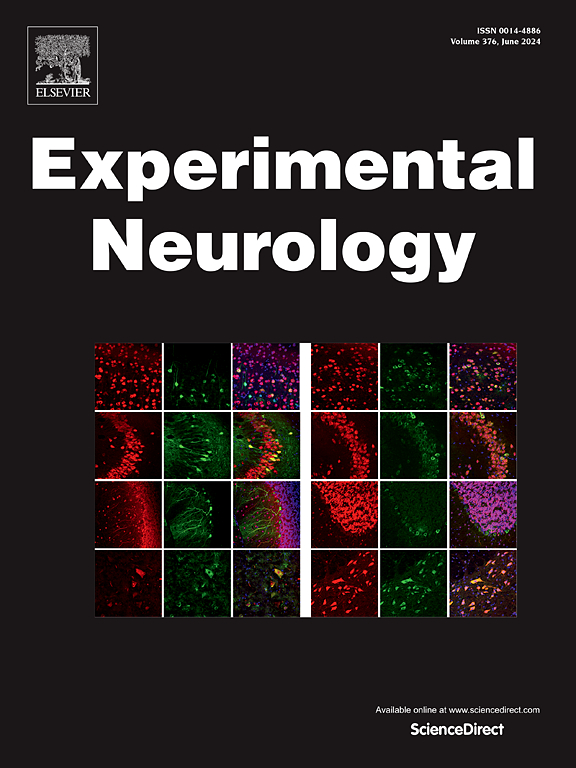Clinical state and future directions of stem cell therapy in stroke rehabilitation
IF 4.6
2区 医学
Q1 NEUROSCIENCES
引用次数: 0
Abstract
Despite substantial advances in the acute management of stroke, it remains a leading cause of adult disability and mortality worldwide. Currently, the reperfusion modalities thrombolysis and thrombectomy benefit only a fraction of patients in the hyperacute phase of ischemic stroke. Thus, with the exception of vagal nerve stimulation combined with intensive physical therapy, there are no approved neuroprotective/neurorestorative therapies for stroke survivors.
Stem cell therapy is a promising treatment for stroke patients and has been the focus of an increasing number of clinical trials over the past two decades. We provide a comprehensive overview of stem cell therapies available to stroke patients, focusing on the different types and doses of stem cells, timing and route of administration, patient selection, clinical outcomes, translational challenges, and future directions for the field. Information on ongoing and completed studies was retrieved from ClinicalTrials.gov, PubMed, Google Scholar, ICTRP, and Scopus.
Autologous bone marrow-derived mononuclear cells (BMMNCs) are the most used, followed by autologous bone marrow stromal cells. IV therapy is typically applied in acute to subacute phases, while IT or IC routes are utilized in chronic phases. Although early-phase trials (Phase I/II) indicate strong safety and tolerability, definitive clinical effectiveness has yet to be unequivocally proven. Cochrane meta-analyses show NIH Stroke Scale improvements, though studies often have high bias and small sample sizes.
Larger randomized, double-blind, placebo-controlled trials are ongoing to refine stem cell transplantation protocols, addressing cell type and source, dosage, timing, patient selection, the potential for combination therapies, and clinical efficacy.

干细胞治疗脑卒中康复的临床现状及未来发展方向。
尽管在中风的急性管理方面取得了重大进展,但它仍然是全世界成年人残疾和死亡的主要原因。目前,再灌注方式溶栓和取栓仅对部分缺血性卒中超急性期患者有益。因此,除了迷走神经刺激结合强化物理治疗外,目前还没有批准的用于中风幸存者的神经保护/神经恢复疗法。干细胞疗法是一种很有前景的治疗中风患者的方法,并且在过去的二十年中已经成为越来越多的临床试验的焦点。我们提供了中风患者可用干细胞治疗的全面概述,重点是不同类型和剂量的干细胞,给药时间和途径,患者选择,临床结果,转化挑战,以及该领域的未来方向。正在进行和已完成的研究的信息从ClinicalTrials.gov、PubMed、谷歌Scholar、ICTRP和Scopus检索。自体骨髓来源的单核细胞(BMMNCs)是最常用的,其次是自体骨髓基质细胞。静脉治疗通常应用于急性至亚急性期,而IT或IC途径用于慢性期。尽管早期临床试验(I/II期)显示出较强的安全性和耐受性,但明确的临床有效性尚未得到明确证实。Cochrane荟萃分析显示NIH中风量表有所改善,尽管研究往往具有高偏倚和小样本量。更大规模的随机、双盲、安慰剂对照试验正在进行中,以完善干细胞移植方案,解决细胞类型和来源、剂量、时间、患者选择、联合治疗的潜力和临床疗效。
本文章由计算机程序翻译,如有差异,请以英文原文为准。
求助全文
约1分钟内获得全文
求助全文
来源期刊

Experimental Neurology
医学-神经科学
CiteScore
10.10
自引率
3.80%
发文量
258
审稿时长
42 days
期刊介绍:
Experimental Neurology, a Journal of Neuroscience Research, publishes original research in neuroscience with a particular emphasis on novel findings in neural development, regeneration, plasticity and transplantation. The journal has focused on research concerning basic mechanisms underlying neurological disorders.
 求助内容:
求助内容: 应助结果提醒方式:
应助结果提醒方式:


